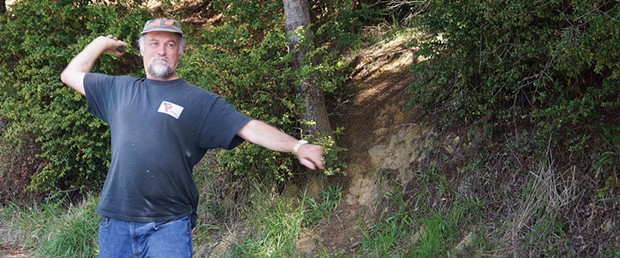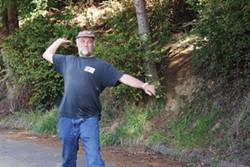[
{
"name": "Top Stories Video Pair",
"insertPoint": "7",
"component": "17087298",
"parentWrapperClass": "fdn-ads-inline-content-block",
"requiredCountToDisplay": "1"
}
]
When I think about Ireland, step dancing, Liam Neeson and Guinness beer come to mind. Just recently I've become aware of another Irish export: road bowling.
As I researched Irish road bowling, it became apparent that it is destined to become the next rage on the empty country roads of the North Coast. Already, competitions have sprung up in West Virginia, upstate New York, rural Georgia and even Kansas. All you need is a 28-ounce iron or steel ball and a quiet road. You don't have to be named Darragh or Fionn or speak Gaelic. No special shoes. No 10 pins.
The rules are simple. The game is played as a singles competition or between teams. Only one ball (known officially as a bowl or bullet) is used per team, with players taking turns throwing. The goal is to take the fewest throws to toss the bowl along a predetermined course of country roads. (This differs from an earlier version of the game in which the test was to go the farthest in 20 throws.) The course can be a few hundred yards or several miles. It can include curves and turns or be completely straight. The bowler can get a running start as long as he or she does not cross the throwing line (referred to as the "butt" in road bowling parlance — don't ask me why), and he or she can throw the bowl underhand or overhand. The bowler's next shot (the throwing line) is made from where the last bowl stopped. If the bowl leaves the road, it is moved to the nearest point on the road.
When throwing around a bend or intersection, the bowl may be thrown through the air over the corner rather than rolled around it. However, the throw must strike the road surface or pass over the road. If the throw fails to reach the road, the player throws again and takes a one-shot penalty. If two or more players or teams have an equal number of shots crossing the finish line, the winner is decided by which final shot goes the farthest distance past the finish line. That's it. No more rules.
Armed with these parameters and four somewhat underweight metal balls that I had managed to locate at Arcata Scrap and Salvage, I coaxed a friend to join me for a morning of Irish road bowling. My wife, who had not been particularly inspired by my description of the game, was surprised I could get any bloody gobdaw to participate in such a harebrained game. It may have helped that it was a beautiful day and we figured the worst that could happen was that we would have a nice walk.
I suggested that we cut our road bowling teeth in the Arcata Bottoms. We quickly learned that crowned roads with a multitude of potholes redirect even our excellent throws into the overgrown roughs along the road. This was followed by the second lesson. Metal balls are very difficult to find in tall grass. Note to self: Paint the balls a bright color or bring a powerful magnet.
We decided to try another location. We parked at the Ma-le'l Dunes South lot and heaved our way along the unpaved access road past the gun club. These conditions may have been more similar to the 17th century, when road bowling first began. We took turns spotting at a reasonable distance from the throwing line, prepared to dodge in the event of a superhuman toss.
Technique became the focus of this match. Our overhand throws had the potential for both greater distance and inaccuracy. Long approach runs to give the throw an extra boost did not have the desired effect, either. Even though we spent far too much time locating errant throws, I was relieved to hear my friend exclaim at one point, "This is great fun."
"Let's head out toward the North Jetty," I suggested after playing our way down and back the access road.
The recently paved roads in the jetty area had broad shoulders and provided a very different challenge. The bowl traveled a long distance in this setting, rewarding throws that managed to stay on the pavement. Several curious bystanders watched, trying to make some sense of the antics of these two grown men.
It seems logical that any match should end at a drinking establishment. In YouTube footage of competitions, it appears that the obligatory pub stop happens both before and after the competition. On the Emerald Isle, wagering also seems to be an essential part of the game. And, according to road bowling historians, it isn't unusual for disputes to erupt between competitors or spectators. Nothing like a good brawl to round out a match.
I've painted the metal balls and we've set a date for the next match. Even my wife has shown some interest. And just like that, Irish road bowling has arrived on the North Coast.
Comments (2)
Showing 1-2 of 2
more from the author
-
Building Trails and Resilience
An update on the virtual Trails Summit
- Jun 11, 2020
-
Thar She Blows
Whale watching on the North Coast
- Mar 19, 2015
-
New at the Zoo
Otters, salmon and eagles, oh my!
- Aug 14, 2014
- More »
Latest in Get Out
Readers also liked…
-
A Walk Among the Spotted Owls
- Apr 27, 2023


































